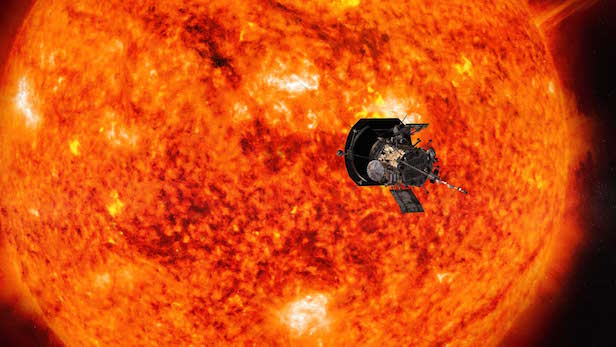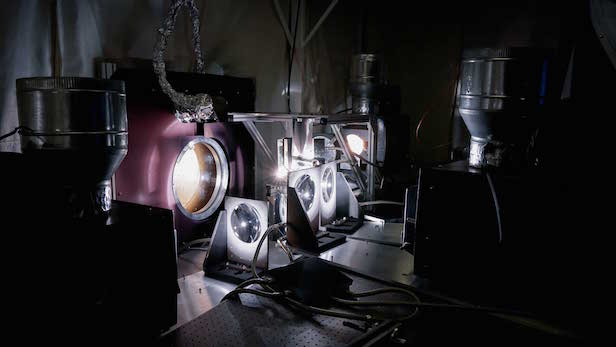Parker Solar Probe sensor passes a final test
The closest Sun-like simulation has put a key sensor for the NASA space probe through its paces

NASA’s Parker Solar Probe will get closer to the Sun then any other spacecraft, effectively ‘touching the Sun’. Image credit: NASA
If you want to get within 6 million kilometres (3.7 million miles) of the Sun, you need to be able to withstand possibly the harshest environment ever experienced by a human-made spacecraft. NASA’s Parker Solar Probe will ‘touch the Sun’, equipped with a key sensor known as a Faraday cup, which will scoop up energetic particles from the Sun’s outer atmosphere. In preparation for the summertime launch, the key sensor has gone through some intense tests designed to simulate the Sun.
This £1.1 billion ($1.5 billion) mission by NASA is due to launch in the summer of 2018, and in order to succeed in this mission, the space probe needs to be able to withstand extreme radiation. The Faraday cup is part of Parker’s Solar Wind Electrons Alphas and Protons (SWEAP) instrument, and in the name of preparation, a model of the cup was recently subject to temperatures exceeding 1,650 degrees Celsius (3,000 degrees Fahrenheit). The cup, built from refractory metals and sapphire crystal insulators at the Oak Ridge National Laboratory’s Plasma Arc Lamp in Tennessee, United States, exceeded expectations.
Justin Kasper, associate professor of climate and space sciences and engineering of the University of Michigan and principal investigator of the SWEAP investigation, and his team created a home-made device called the Solar Environment Simulator. This contraption rinsed the model cup with roughly 10 kilowatts of light – which is enough to heat a sheet of metal to 980 degrees Celsius (1,800 degrees Fahrenheit) in seconds – putting it through its paces, and proving successful in analysing the simulated solar wind.
“Watching the instrument track the signal from the ion beam as if it was plasma flowing from the Sun was a thrilling preview of what we will see with Parker Solar Probe,” says Kasper.
The Sun’s atmosphere has been known to bring an upheaval of plasma into space; these are referred to as Coronal Mass Ejections. These ejections are powerful enough that they can reach the outer planets of our Solar System. As scientists are not able to predict these events, CMEs can unexpectedly create geomagnetic oscillations that tamper with satellite electronics, interfere with GPS and radio communications and, in the worst-case scenario, power grids can become overloaded and cause power cuts.
The aim of the Parker Solar Probe is to see what makes up the Sun’s corona – the outer atmosphere of the Sun consisting of copious amounts of plasma – and what is driving these expulsions of solar material. With such information, scientists on Earth can be better prepared for such harmful events, producing a better early-warning system.
The Faraday cup is a part of the team of instruments aiming to find out these answers. To test the model cup, researchers had to invent a new simulator, which was located at the Smithsonian Astrophysical Observatory in Cambridge, Massachusetts, United States. Inside this room resembling an operating room was a quartet of modified older-model IMAX projectors designed to recreate the Sun’s light.

This simulation laboratory is based at the Smithsonian Astrophysical Observatory in Cambridge, Massachusetts, United States. Image credit: Levi Hutmacher/Michigan Engineering
“It turns out a movie theatre bulb on an IMAX projector runs at about the same (5,420 degrees Celsius) 5,700 degrees Kelvin – the same effective temperature as the surface of the Sun,” says Kasper. “And it gives off nearly the same spectrum of light as the surface.”
As there is no atmosphere in space, a more ideal environment for testing the circumsolar environment would have as little atmosphere as possible. This is why the cup was also placed inside a seven-foot-long silver metal vacuum for testing. The night before testing, the researchers started eliminating all the air in the chamber, and by the time testing came round, the chamber registered roughly one-billionth of the Earth’s atmosphere.
With the four IMAX projectors pointing at the vacuum tube and the Faraday cup, there was only one more aspect of the simulator missing: the ability to generate the kind of particles that the Faraday will be sensing and analysing. For this the team brought forth an ion gun, which was attached to the vacuum tube hatch and pointed at the Faraday cup.
“The ion gun takes a pellet of metal and heats it up,” says Anthony Case, an astrophysicist at the Harvard Smithsonian Institute for Astrophysics. “When it gets hot, ions start boiling off this piece of metal. Then you hook it up to a battery, accelerating the ions out of the gun. And we can direct them right toward the Faraday cup’s aperture, where they’ll be measured.”
The final test of the Faraday cup could handle the heat and stretch beyond expectations. This is an extremely positive sign for the Parker Solar Probe’s launch in the summer.
“As for the test today, it confirmed what I had suspected – when you take an amazing team of scientists and engineers, give them a complex, difficult, interesting project and the motivation of exploring a region of the universe humankind has never been to before, remarkable things happen,” says Kelly Korreck, a U-M alumna and astrophysicist at the institute, who serves as head of science operations on Parker’s SWEAP investigation as well as SWEAP activities for the Smithsonian.
Keep up to date with the latest reviews in All About Space – available every month for just £4.99. Alternatively you can subscribe here for a fraction of the price!




